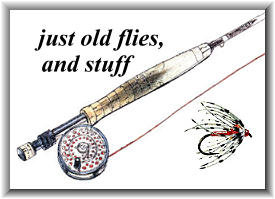The Logie is a bit of an oddball. First, it's one of a
handful of old feather winged salmon flies that is still
in use today. Designed for the Scottish river Dee, it is
today used as a low-water fly, on a bright day when the
water is clear, and you don't want to use a fly that's too
"pretentious." The second thing that's odd about the fly,
at least to a salmon fly tier, is how it has changed.
Salmon flies are typically recognized by their bodies.
There are no rules where the wings are concerned, or
certainly few, but the rules regarding bodies are rigid
and cast in stone. I can tie three Silver Doctors that
look nothing at all alike at first glance. The uninitiated
would say they were completely different patterns. But if
they all have silver tinsel bodies, a red berlin wool butt
section, and a red berlin wool head, chances are very good
that they're all Silver Doctors, even if they look like
different flies. Not so with the Logie. The body on the
Logie has changed. The original had a body of dark claret
silk, and was presented that way by Hardy and Hale, as well
as Kelson. But along comes Pryce-Tannatt, and he changes
everything. The body is now 2/5 primrose floss silk and
the rest red floss silk. Other things about the pattern
remain the same, except he does away with the jungle cock
cheeks as well. This is the pattern that has survived to
this day. However, it must be noted that it is a stunning
violation of every "rule" of salmon fly tying to seriously
change the body of a recognized pattern, and yet that's just
what Pryce-Tannatt did. In light of the fact that his pattern
is still tied and fished today, we can only surmise that he
knew what he was doing.
I'd like to say a word here about Warren Duncan. He is a
noted professional salmon fly tier from New Brunswick,
Canada, and there is an article in the recent Art of
Angling Journal featuring his excellently tied flies.
If you can get a copy, there are beautifully tied versions
of most of the flies used for salmon fishing today. Though
he ties mostly hair-wings these days, there is a lovely
Logie on the second page of his flies, lending credence to
its viability. Stan Headley also features the fly in his
book Trout and Salmon Flies of Scotland. He
mentions the original, devised by W. Brown, with its claret
body, but shows the recipe for the one I've done here. Here
it is:
The Logie
Hook: Singles & doubles, 4-12.
Silk: Yellow.
Tag: Fine oval silver.
Tail: Golden Pheasant Crest.
Body: In two parts: first two fifths-yellow
floss; remainder-red floss.
Rib: Oval silver.
Throat: Light blue cock.
Wing: Yellow swan or goose veiled with bronze mallard.
Head: Black.
Credits:
Classic Salmon Flies by Mikael Frodin;
Trout and Salmon Flies of Scotland by Stan Headley;
Art of Angling Journal, Volume 2 Issue 4, Paul Schmookler
and Ingrid Sils ~ Eric Austin
|

